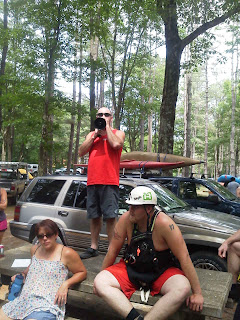The is a copy and paste from the Greenfield Recorder. If there is a copyright issue here, please contact me and ill be happy to take it off. Go team SMAC Down!
Greenfield Recorder 07/19/2012, Page B01
No race for the weary
By JASON BUTYNSKI
Recorder Staff
Team SMAC Down members pose for a shot Saturday morning at the Mount
Greylock Vistors’ Center in Adams before embarking on a grueling,
26-hour, 200-mile, cross-state relay race that ended Sunday in Boston
with a second- place showing. The team members are (standing), left to
right, James Callaway, Donna Utakis, Carla Halpern, Mike Towsley, John
McCarthy, Leeann Cerpovicz and daughter Allie Cerpovicz. In the front
row, left to right, are Rebeka Slowzak, Garth Shaneyfelt, Marc
Guillaume, Kristin Tetrault, and Luca Grisa.
Driving from the summit of Mount Greylock to Boston would not be a short trip.
Try running it.
Try running it.
That’s exactly what a dozen members from the Sugarloaf Mountain Athletic Club did this past weekend, when they took part in the Mass Dash Relay to benefit the Dana-Farber Cancer Institute.
The Mash Dash is in its third year of existence and covers 200 miles, beginning at the Mount Greylock Visitors Center in Adams and ending on the beach just past the John F. Kennedy Presidential Library and Museum in Boston.
The team, called Team SMAC Down, included captain Marc Guillaume (Greenfield), Garth Shaneyfelt (Greenfield), Mike Townsley (Bernardston), Carla Halpern (New Salem), Luca Grisa (Amherst), James Callaway (Keene, N.H.), John McCarthy, Kristin Tetrault, Donna Utakis, Leeann Cerpovicz, Allie Cerpovicz, and Rebeka Slozak. The 12 runners competed against 30 other teams and came home with the silver medal, finishing the course in second place in 25 hours, 58 minutes. The winning team finished in 23 hours, 58 minutes, 10 seconds.
But running a 200-mile relay is about more than just passing a baton and trying to finish ahead of the other teams. There’s much more to it than that.
The course was made up of 36 legs, with each team member running three. Each leg varied in distance, but Bernardston resident and SMAC Down member Townsley said the running ability of each team member also varied, so things worked out well for the team to perform at such a high level.
The team was broken up into two vans, so that when the first van was running, the second van could move ahead and give members a break. While a member of a van was running, the other members of the same van were able not only to support the runner, but also to provide water and other liquids to stay hydrated.
Staying hydrated was crucial with the temperatures soaring into the 90s with high humidity throughout the day, then dipping into the low 70s with high humidity at night. Townsley said many of the runners would inform teammates in the same van when they needed a drink and the van would move ahead to accommodate the request. Teammates would then jog alongside the runner and pass a drink to help cool the him or her down.
“It was a pretty good feeling to see all the members working hard like that,” Townsley said of the hydration efforts. “Hydration and team support was a major contributor to (our) success.”
Townsley also said that members of the team were able to stop off at the Daughters of the American Revolution State Forest in Goshen to jump into the Highland Lake and cool off. But aside from the quick swim, it was all about drinking water, drinking water and more water.
A trip from Adams to Boston as the crow flies would not total up to 200 miles, so as you can imagine, it full of turns that took the team through a number of towns.
Another issue was that, unlike a smaller, more normal-sized road race, was navigating a 200-mile course on See RACE Page B3
■ Race: Local heroes
From Page B1
which a runner could easily get lost on. With all the twists and turns, you might think runners might miss a turn and run off-course. But event organizers made sure this didn’t happen. All 200 miles were marked with signs at all of the turns and cones with blinking lights so that nighttime runners could see the turns.
“The people that put this race on did a phenomenal job,” Townsley said. “All corners and turns were marked with signs. It was a major concern going into the race. You’re out there and there’s no course officials. But the people who put on the race did a great job.”
Running a race at night was likely a new experience for many of the participants. Runners were required to wear flourescent vests, a blinking light and a headlamp for their safety. Townsley noticed a distinct difference running at night.
“Time tends to go a little bit faster,” he explained. “Even though some of the runners were running six to nine miles, it was like there was no difference in time from someone running less miles.”
After running during the early part of the night, Townsley said his van raced ahead to Hopkinton and arrived at the town common where the Boston Marathon begins. The team pulled out sleeping bags around 2:30 a.m. and tried to catch some quick Zs, getting about two hours before waking up and preparing for their next transition at 5:30.
“It was a little bit different, laying on a town common in a place you don’t know,” Townsley joked.
After starting at 10 a.m. on Saturday morning, the team finally crossed the finish line around noon on Sunday. Many of the participants then headed into the ocean to cool down and celebrate the second-place finish.
A fitting way to wrap up a 200-mile journey.






